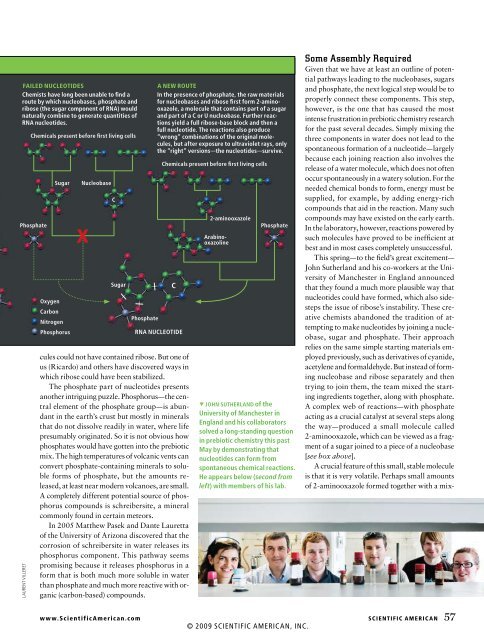Ricardo-Szostak-SA2009
Ricardo-Szostak-SA2009
Ricardo-Szostak-SA2009
- No tags were found...
You also want an ePaper? Increase the reach of your titles
YUMPU automatically turns print PDFs into web optimized ePapers that Google loves.
fAileD nucleotiDeS<br />
Chemists have long been unable to find a<br />
route by which nucleobases, phosphate and<br />
ribose (the sugar component of RNA) would<br />
naturally combine to generate quantities of<br />
RNA nucleotides.<br />
laurent villeret<br />
Chemicals present before first living cells<br />
Phosphate<br />
oxygen<br />
Carbon<br />
Nitrogen<br />
sugar Nucleobase<br />
x<br />
Phosphorus RNA NUClEoTIDE<br />
C<br />
sugar<br />
Phosphate<br />
cules could not have contained ribose. But one of<br />
us (<strong>Ricardo</strong>) and others have discovered ways in<br />
which ribose could have been stabilized.<br />
The phosphate part of nucleotides presents<br />
another intriguing puzzle. Phosphorus—the central<br />
element of the phosphate group—is abundant<br />
in the earth’s crust but mostly in minerals<br />
that do not dissolve readily in water, where life<br />
presumably originated. So it is not obvious how<br />
phosphates would have gotten into the prebiotic<br />
mix. The high temperatures of volcanic vents can<br />
convert phosphate-containing minerals to soluble<br />
forms of phosphate, but the amounts released,<br />
at least near modern volcanoes, are small.<br />
A completely different potential source of phosphorus<br />
compounds is schreibersite, a mineral<br />
commonly found in certain meteors.<br />
In 2005 Matthew Pasek and Dante Lauretta<br />
of the University of Arizona discovered that the<br />
corrosion of schreibersite in water releases its<br />
phosphorus component. This pathway seems<br />
promising because it releases phosphorus in a<br />
form that is both much more soluble in water<br />
than phosphate and much more reactive with organic<br />
(carbon-based) compounds.<br />
A neW route<br />
In the presence of phosphate, the raw materials<br />
for nucleobases and ribose first form 2-aminooxazole,<br />
a molecule that contains part of a sugar<br />
and part of a C or U nucleobase. Further reactions<br />
yield a full ribose-base block and then a<br />
full nucleotide. The reactions also produce<br />
“wrong” combinations of the original molecules,<br />
but after exposure to ultraviolet rays, only<br />
the “right” versions—the nucleotides—survive.<br />
Chemicals present before first living cells<br />
C<br />
2-aminooxazole<br />
Arabinooxazoline<br />
Phosphate<br />
� JoHN sUTHERlAND of the<br />
University of Manchester in<br />
England and his collab orators<br />
solved a long-standing question<br />
in prebiotic chemistry this past<br />
May by demonstrating that<br />
nucleotides can form from<br />
spontaneous chemical reactions.<br />
He appears below (second from<br />
left) with members of his lab.<br />
Some Assembly Required<br />
Given that we have at least an outline of potential<br />
pathways leading to the nucleobases, sugars<br />
and phosphate, the next logical step would be to<br />
properly connect these components. This step,<br />
however, is the one that has caused the most<br />
intense frustration in prebiotic chemistry research<br />
for the past several decades. Simply mixing the<br />
three components in water does not lead to the<br />
spontaneous formation of a nucleotide—largely<br />
be cause each joining reaction also involves the<br />
release of a water molecule, which does not often<br />
occur spontaneously in a watery solution. For the<br />
needed chemical bonds to form, energy must be<br />
supplied, for example, by adding energy-rich<br />
compounds that aid in the reaction. Many such<br />
compounds may have existed on the early earth.<br />
In the laboratory, however, reactions powered by<br />
such molecules have proved to be inefficient at<br />
best and in most cases completely unsuccessful.<br />
This spring—to the field’s great excitement—<br />
John Sutherland and his co-workers at the University<br />
of Manchester in England announced<br />
that they found a much more plausible way that<br />
nucleotides could have formed, which also sidesteps<br />
the issue of ribose’s instability. These creative<br />
chemists abandoned the tradition of attempting<br />
to make nucleotides by joining a nucleobase,<br />
sugar and phosphate. Their approach<br />
relies on the same simple starting materials employed<br />
previously, such as derivatives of cyanide,<br />
acetylene and formaldehyde. But instead of forming<br />
nucleobase and ribose separately and then<br />
trying to join them, the team mixed the start -<br />
ing ingredients together, along with phosphate.<br />
A complex web of reactions—with phosphate<br />
acting as a crucial catalyst at several steps along<br />
the way—produced a small molecule called<br />
2-amino oxazole, which can be viewed as a fragment<br />
of a sugar joined to a piece of a nucleobase<br />
[see box above].<br />
A crucial feature of this small, stable molecule<br />
is that it is very volatile. Perhaps small amounts<br />
of 2-aminooxazole formed together with a mix-<br />
www.ScientificAmerican.com Scientific AmericAn 57<br />
© 2009 SCIENTIFIC AMERICAN, INC.


